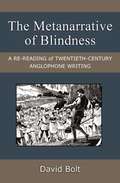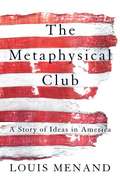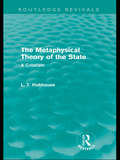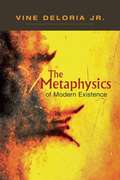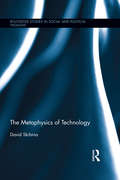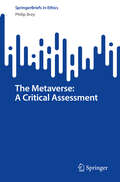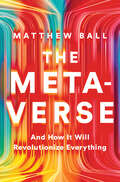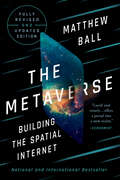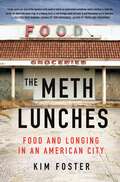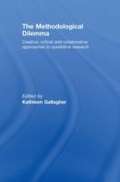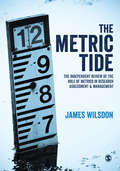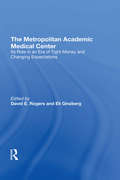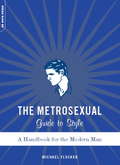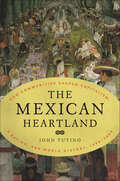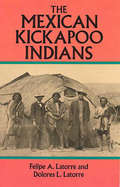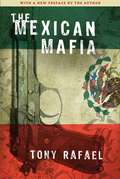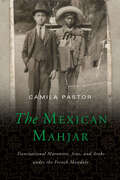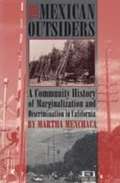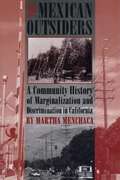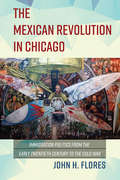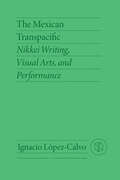- Table View
- List View
The Metanarrative Of Blindness: A Re-reading Of Twentieth-century Anglophone Writing
by David Bolt<P>Although the theme of blindness occurs frequently in literature, literary criticism has rarely engaged the experiential knowledge of people with visual impairments. The Metanarrative of Blindness counters this trend by bringing to readings of twentieth-century works in English a perspective appreciative of impairment and disability. Author David Bolt examines representations of blindness in more than forty literary works, including writing by Kipling, Joyce, Synge, Orwell, H. G. Wells, Susan Sontag, and Stephen King, shedding light on the deficiencies of these representations and sometimes revealing an uncomfortable resonance with the Anglo-American science of eugenics. <P>What connects these seemingly disparate works is what Bolt calls “the metanarrative of blindness,” a narrative steeped in mythology and with deep roots in Western culture. Bolt examines literary representations of blindness using the analytical tools of disability studies in both the humanities and social sciences. His readings are also broadly appreciative of personal, social, and cultural aspects of disability, with the aim of bringing literary scholars to the growing discipline of disability studies, and vice versa. This interdisciplinary monograph is relevant to people working in literary studies, disability studies, psychology, sociology, applied linguistics, life writing, and cultural studies, as well as those with a general interest in education and representations of blindness.
The Metaphor of Celebrity
by Joel DeshayeThe Metaphor of Celebrity is an exploration of the significance of literary celebrity in Canadian poetry. It focuses on the lives and writing of four widely recognized authors who wrote about stardom - Leonard Cohen, Michael Ondaatje, Irving Layton, and Gwendolyn MacEwen - and the specific moments in Canadian history that affected the ways in which they were received by the broader public.Joel Deshaye elucidates the relationship between literary celebrity and metaphor in the identity crises of celebrities, who must try to balance their public and private selves in the face of considerable publicity. He also examines the ways in which celebrity in Canadian poetry developed in a unique way in light of the significant cultural events of the decades between 1950 and 1980, including the Massey Commission, the flourishing of Canadian publishing, and the considerable interest in poetry in the 1960s and 1970s, which was followed by a rapid fall from public grace, as poetry was overwhelmed by greater popular interest in Canadian novels.
The Metaphysical Club: A Story of Ideas in America
by Louis MenandWinner of the 2002 Pulitzer Prize for History, a riveting, original book about the creation of modern American thought. The Metaphysical Club was an informal group that met in Cambridge, Massachusetts, in 1872, to talk about ideas. Its members included Oliver Wendell Holmes, Jr., future associate justice of the United States Supreme Court; William James, the father of modern American psychology; and Charles Sanders Peirce, logician, scientist, and the founder of semiotics. The Club was probably in existence for about nine months. No records were kept. The one thing we know that came out of it was an idea -- an idea about ideas.
The Metaphysical Theory of the State: A Criticism - Primary Source Edition (Routledge Revivals)
by L. T. HobhouseOriginally published in 1918, this enduring work by renowned sociologist and Liberal politician Leonard Trelawny Hobhouse encompasses a series of five key lectures, first delivered at the London School of Economics in the autumn of 1917. Outlining Hobhouse's theories on social investigation, freedom, law and the will of the state, this edition revives an important work, which has long been unavailable.
The Metaphysics of Modern Existence
by David E. Wilkins Vine Deloria Jr. Daniel R. WildcatVine Deloria Jr., named one of the most influential religious thinkers in the world by Time, shares a framework for a new vision of reality. Bridging science and religion to form an integrated idea of the world, while recognizing the importance of tribal wisdom, The Metaphysics of Modern Existence delivers a revolutionary view of our future and our world. David E. Wilkins holds the McKnight Presidential Professorship in American Indian Studies at the University of Minnesota. Daniel R. Wildcat is the director of the American Indian studies program and the Haskell Environmental Research Studies Center at Haskell Indian Nations University.
The Metaphysics of Technology (Routledge Studies in Social and Political Thought #94)
by David SkrbinaWhat is technology? Why does it have such power in our lives? Why does it seemingly progress of its own accord, and without regard to social or environmental well-being? The quest for the essence of technology is an old one, with roots in the pre-Socratic philosophy of ancient Greece. It was then that certain thinkers first joined the ideas of technê and logos into a single worldview. The Greeks saw it as a kind of world-force, present in both the works of men and in nature itself. It was the very creative power of the cosmos. In the 20th century, German thinkers like Dessauer, Juenger, and Heidegger sought the metaphysical basis of technology, with varying success. French theologian Jacques Ellul argued persuasively that technology was an autonomous force of nature that determined all aspects of human existence, but he neglected the metaphysical underpinnings. Recent writers in the philosophy of technology have generally eschewed metaphysics altogether, preferring to concentrate on constructivist models or pragmatic analyses. In the present work, Skrbina returns to a classic metaphysical approach, seeking not so much an essence of technology but rather a deep and penetrating analysis of the entire technological phenomenon. Drawing on the Greeks, he argues for a teleological metaphysics in which increasing order in the universe is itself defined as a technological process. On this reading, all of reality constitutes a technical sphere, a "pantechnikon," of universal scope. This work — the first-ever book-length treatment of the topic — breaks new ground by providing an in-depth and critical study of the metaphysics of technology, as well as drawing out the practical consequences. Technology poses significant risks to humanity and the planet, risks that can be mitigated through a detailed philosophical analysis.
The Metaverse: A Critical Assessment (SpringerBriefs in Ethics)
by Philip BreyThis book offers an extensive assessment of the nature and feasibility of the metaverse and is the first to critically examine its social and ethical implications. The metaverse is, in essence, an envisioned future merger of virtual and augmented reality (VR and AR) and the internet, enabling real-time immersive interaction and activities like work, play, socializing, and entertainment. Major tech companies like Meta, Microsoft, Apple and NVIDIA have been investing billions in metaverse technologies, with generative AI accelerating progress. This book examines how these efforts could culminate in the metaverse, exploring its potential forms, implications, and the social and ethical challenges it may pose—along with recommendations for responsible innovation. The book is aimed at stakeholders shaping the metaverse—developers, creators, investors, business leaders, and thought leaders in technologies like VR, AR, Web3, blockchain, and AI. It also serves scholars and students in applied ethics, the social sciences, and the humanities, including fields such as media studies, psychology, and law. General readers interested in the metaverse and emerging technologies will find it both accessible and engaging. Endorsements: "In this book, the talented and eloquent philosopher Philip Brey carefully explains the history and ideas behind the metaverse, and the prospects for its further development and adoption. That detailed information, meticulously presented, makes this a valuable read. But that is just the start. In later chapters, Brey just as skillfully describes the opportunities and vulnerabilities that a metaverse is likely to generate. These chapters are thorough, precise, and offer profound insights into our possible futures. Some of the possibilities are exciting. Others are frightening." –Keith W. Miller, University of Missouri–St. Louis.
The Metaverse: And How It Will Revolutionize Everything
by Matthew BallINTERNATIONAL BESTSELLER — United States, Canada, United Kingdom, and China (Wall Street Journal, Associated Press, Nielsen Bookscan, Publishers Weekly, USA Today, Toronto Star, Globe & Mail, BookNet Canada, Bookseller.com, Bookdao/Nielsen, JD, DangDang) Tim Sweeney (CEO of Fortnite-maker Epic Games): “Matthew Ball’s essays have defined, analyzed, and inspired the Metaverse for years. His book is an approachable and essential guide to the strategic, technical, and philosophical foundations of this new medium.” Derek Thompson (Atlantic staff writer and national best-selling author of Hit Makers): “This book feels like a rare achievement: a definitive statement about an emerging phenomenon that could shape the digital world, the global economy, and the very experience of human consciousness.” From the leading theorist of the Metaverse comes the definitive account of the next internet: what the Metaverse is, what it will take to build it, and what it means for all of us. The term “Metaverse” is suddenly everywhere, from the front pages of national newspapers and the latest fashion trends to the plans of the most powerful companies in history. It is already shaping the policy platforms of the US government, the European Union, and the Chinese Communist Party. But what, exactly, is the Metaverse? As pioneering theorist and venture capitalist Matthew Ball explains, it is a persistent and interconnected network of 3D virtual worlds that will eventually serve as the gateway to most online experiences, and also underpin much of the physical world. For decades, these ideas have been limited to science fiction and video games, but they are now poised to revolutionize every industry and function, from finance and healthcare to education, consumer products, city planning, dating, and well beyond. Taking us on an expansive tour of the “next internet,” Ball demonstrates that many proto-Metaverses are already here, such as Fortnite, Minecraft, and Roblox. Yet these offer only a glimpse of what is to come. Ball presents a comprehensive definition of the Metaverse before explaining the technologies that will power it—and the breakthroughs that will be necessary to fully realize it. He addresses the governance challenges the Metaverse entails; investigates the role of Web3, blockchains, and NFTs; and predicts Metaverse winners and losers. Most importantly, he examines many of the Metaverse’s almost unlimited applications. The internet will no longer be at arm’s length; instead, it will surround us, with much of our lives, labor, and leisure taking place inside the Metaverse. Bringing clarity and authority to a frequently misunderstood concept, Ball foresees trillions of dollars in new value—and the radical reshaping of society.
The Metaverse: Fully Revised and Updated Edition: Building the Spatial Internet
by Matthew BallFrom the leading theorist of the Metaverse comes the eagerly anticipated, revised and updated account of the next internet: what the Metaverse is, what it will take to build it, and what it means for all of us. A Hudson Booksellers, Amazon, Guardian, Financial Times, Economist, and ByteDance Toutiao Best Book of the Year In this substantially revised and updated edition of his internationally best-selling book, pioneering theorist and entrepreneur Matthew Ball goes beyond the hype cycle to present a definitive account of the future of the internet. The Metaverse, according to Ball’s industry-shaping definition, is a persistent and interconnected network of 3D virtual worlds that will eventually serve as the gateway to most online experiences and underpin much of the physical world. As Ball recounts, the Metaverse is a thirty-year-old term, and the core ideas and technologies behind it have been in development for nearly a century. Only recently, however, did this fantastical concept begin to leap from the pages of science fiction and depths of national research labs to the forefront of consumer technology, industrial engineering, healthcare, education, dating, and more. From the history of video games and virtual reality to “proto-metaverses” such as Second Life, Fortnite, and Roblox to Generative AI and the groundbreaking films and television series of the Walt Disney Company, Ball points out that the Metaverse is already emerging around us (and doesn’t require a headset). Still, there are many breakthroughs required to fully realize the Metaverse, and he describes each in approachable but expert detail. Ball also lays out how governmental policy, the philosophy of Big Tech leaders, artificial general intelligence, economics, and human rights will shape the development of the Metaverse. Famous for his ability to bring clarity to complex and misunderstood topics, Ball demonstrates that the race to build the Metaverse—also known as the “spatial” or “immersive” internet—is only accelerating. The Metaverse will endure as an indispensable guide for enthusiasts, tech aficionados, and anyone curious about the profound transformations underway in our increasingly interconnected world.
The Meth Lunches: Food and Longing in an American City
by Kim FosterJames Beard Award–winning author Kim Foster reveals a new portrait of hunger and humanity in America. Food is a conduit for connection; we envision smiling families gathered around a table—eating, happy, content. But what happens when poverty, mental illness, homelessness, and addiction claim a seat at that table? In The Meth Lunches, Kim Foster peers behind the polished visions of perfectly curated dinners and charming families to reveal the complex reality when poverty and food intersect. Whether it’s heirloom vegetables or a block of neon-yellow government cheese, food is both a basic necessity and a nuanced litmus test: what and how we eat reflects our communities, our cultures, and our place in the world. The Meth Lunches gives a glimpse into the lives of people living in Foster’s Las Vegas community—the grocery store cashier who feels safer surrounded by food after surviving a childhood of hunger; the inmate baking a birthday cake with coffee creamer and Sprite; the unhoused woman growing scallions in the slice of sunlight on her passenger seat. This is what food looks like in the lives of real people. The Meth Lunches reveals stories of dysfunction intertwined with hope, of the insurmountable obstacles and fierce determination all playing out on the plates of ordinary Americans. It’s a bold invitation to pull up a chair and reconsider our responsibilities to the most vulnerable among us. Welcome to the table.
The Methodological Dilemma: Creative, Critical and Collaborative Approaches to Qualitative Research
by Kathleen GallagherBoth thought-provoking and challenging to the way research is planned and undertaken, this vital new book will equip researchers with a variety of critical, creative and post-positivist solutions to dilemmas that plague qualitative research.
The Metric Tide: Independent Review of the Role of Metrics in Research Assessment and Management
by James Wilsdon‘Represents the culmination of an 18-month-long project that aims to be the definitive review of this important topic. Accompanied by a scholarly literature review, some new analysis, and a wealth of evidence and insight... the report is a tour de force; a once-in-a-generation opportunity to take stock.’ – Dr Steven Hill, Head of Policy, HEFCE, LSE Impact of Social Sciences Blog ‘A must-read if you are interested in having a deeper understanding of research culture, management issues and the range of information we have on this field. It should be disseminated and discussed within institutions, disciplines and other sites of research collaboration.’ – Dr Meera Sabaratnam, Lecturer in International Relations at the School of Oriental and African Studies, University of London, LSE Impact of Social Sciences Blog Metrics evoke a mixed reaction from the research community. A commitment to using data and evidence to inform decisions makes many of us sympathetic, even enthusiastic, about the prospect of granular, real-time analysis of our own activities. Yet we only have to look around us at the blunt use of metrics to be reminded of the pitfalls. Metrics hold real power: they are constitutive of values, identities and livelihoods. How to exercise that power to positive ends is the focus of this book. Using extensive evidence-gathering, analysis and consultation, the authors take a thorough look at potential uses and limitations of research metrics and indicators. They explore the use of metrics across different disciplines, assess their potential contribution to the development of research excellence and impact and consider the changing ways in which universities are using quantitative indicators in their management systems. Finally, they consider the negative or unintended effects of metrics on various aspects of research culture. Including an updated introduction from James Wilsdon, the book proposes a framework for responsible metrics and makes a series of targeted recommendations to show how responsible metrics can be applied in research management, by funders, and in the next cycle of the Research Excellence Framework. The metric tide is certainly rising. Unlike King Canute, we have the agency and opportunity – and in this book, a serious body of evidence – to influence how it washes through higher education and research.
The Metric Tide: Independent Review of the Role of Metrics in Research Assessment and Management
by James Wilsdon‘Represents the culmination of an 18-month-long project that aims to be the definitive review of this important topic. Accompanied by a scholarly literature review, some new analysis, and a wealth of evidence and insight... the report is a tour de force; a once-in-a-generation opportunity to take stock.’ – Dr Steven Hill, Head of Policy, HEFCE, LSE Impact of Social Sciences Blog ‘A must-read if you are interested in having a deeper understanding of research culture, management issues and the range of information we have on this field. It should be disseminated and discussed within institutions, disciplines and other sites of research collaboration.’ – Dr Meera Sabaratnam, Lecturer in International Relations at the School of Oriental and African Studies, University of London, LSE Impact of Social Sciences Blog Metrics evoke a mixed reaction from the research community. A commitment to using data and evidence to inform decisions makes many of us sympathetic, even enthusiastic, about the prospect of granular, real-time analysis of our own activities. Yet we only have to look around us at the blunt use of metrics to be reminded of the pitfalls. Metrics hold real power: they are constitutive of values, identities and livelihoods. How to exercise that power to positive ends is the focus of this book. Using extensive evidence-gathering, analysis and consultation, the authors take a thorough look at potential uses and limitations of research metrics and indicators. They explore the use of metrics across different disciplines, assess their potential contribution to the development of research excellence and impact and consider the changing ways in which universities are using quantitative indicators in their management systems. Finally, they consider the negative or unintended effects of metrics on various aspects of research culture. Including an updated introduction from James Wilsdon, the book proposes a framework for responsible metrics and makes a series of targeted recommendations to show how responsible metrics can be applied in research management, by funders, and in the next cycle of the Research Excellence Framework. The metric tide is certainly rising. Unlike King Canute, we have the agency and opportunity – and in this book, a serious body of evidence – to influence how it washes through higher education and research.
The Metropolitan Academic Medical Center: Its Role In An Era Of Tight Money And Changing Expectations
by Eli Ginzberg David E. RogersThe Metropolitan Academic Medical Center provides a careful reexamination of developments of the past decade, offers insights for improving medical education, biomedical research, and health care services, and examines the fate of the medical academy.
The Metrosexual Guide To Style: A Handbook For The Modern Man
by Michael FlockerThe old-fashioned, repressed, un-moisturized man has been banished to the hinterlands and a new breed is taking center stage. He is a man of style, sophistication, and security, just as strong and confident as his predecessor, but far more diverse in his interests, his tastes, and, most importantly, his self-image. He may be seen at an NBA game one night and an art gallery opening the next. Able to navigate any social setting, he is informed, influential, intriguing, and very much in vogue these days. He is the new male ideal: the metrosexual man.So how can the average Joe keep up with this new version of cool? How should he behave, what shoes should he wear, and what CDs should he have in his collection? Answers to these questions and so many other pressing concerns can be found in The Metrosexual Guide to Style. Filled with entertaining anecdotes, famous quotes, helpful hints, dos and don'ts, recommendations and potential pitfalls, this handy guidebook covers everything from dining out to fashion and personal style, home décor to the Metro-mindset. It is the one-stop shop for the impeccably groomed and savvy modern man.
The Mexican Aristocracy: An Expressive Ethnography, 1910-2000
by Hugo G. NutiniThe Mexican aristocracy today is simultaneously an anachronism and a testimony to the persistence of social institutions. Shut out from political power by the democratization movements of the twentieth century, stripped of the basis of its great wealth by land reforms in the 1930s, the aristocracy nonetheless maintains a strong sense of group identity through the deeply held belief that their ancestors were the architects and rulers of Mexico for nearly four hundred years.
The Mexican Heartland: How Communities Shaped Capitalism, a Nation, and World History, 1500–2000
by John TutinoA major new history of capitalism from the perspective of the indigenous peoples of Mexico, who sustained and resisted it for centuriesThe Mexican Heartland provides a new history of capitalism from the perspective of the landed communities surrounding Mexico City. In a sweeping analytical narrative spanning the sixteenth century to today, John Tutino challenges our basic assumptions about the forces that shaped global capitalism—setting families and communities at the center of histories that transformed the world.Despite invasion, disease, and depopulation, Mexico’s heartland communities held strong on the land, adapting to sustain and shape the dynamic silver capitalism so pivotal to Spain’s empire and world trade for centuries after 1550. They joined in insurgencies that brought the collapse of silver and other key global trades after 1810 as Mexico became a nation, then struggled to keep land and self-rule in the face of liberal national projects. They drove Zapata’s 1910 revolution—a rising that rattled Mexico and the world of industrial capitalism. Although the revolt faced defeat, adamant communities forced a land reform that put them at the center of Mexico’s experiment in national capitalism after 1920. Then, from the 1950s, population growth and technical innovations drove people from rural communities to a metropolis spreading across the land. The heartland urbanized, leaving people searching for new lives—dependent, often desperate, yet still pressing their needs in a globalizing world.A masterful work of scholarship, The Mexican Heartland is the story of how landed communities and families around Mexico City sustained silver capitalism, challenged industrial capitalism—and now struggle under globalizing urban capitalism.
The Mexican Kickapoo Indians (Native American)
by Felipe A. Latorre Dolores L. LatorreFascinating anthropological study of a group of Kickapoo Indians who left their Wisconsin homeland for Mexico over a century ago. Focus on why they left, why they settled in northern Mexico, how they live. "One of the most thorough and authentic studies...yet produced..." -- Publishers Weekly. 26 illustrations. Map. Introduction. Bibliography. Index.
The Mexican Mafia
by Tony RafaelIt has been called the most dangerous gang in American history. In Los Angeles alone it is responsible for over 100 homicides per year. Although it has fewer than 300 members, it controls a 40,000-strong street army that is eager to advance its agenda. It waves the flag of the Black Hand and its business is murder. Although known on the streets for over fifty years, the Mexican Mafia has flown under the radar of public awareness and has flourished beneath a deep cover of secrecy. Members are forbidden even to acknowledge its existence. For the first time in its history, the Mexican Mafia is now getting the attention it has been striving to avoid. In this briskly written and thoroughly researched book, Tony Rafael looks at the birth and the blood-soaked growth of this criminal enterprise through the eyes of the victims, the dropouts, the cops and DAs on the front lines of the war against the Mexican Mafia. The first book ever published on the subject, Southern Soldiers is a pioneering work that unveils the operations of this California prison gang and describes how it grew from a small clique of inmates into a transnational criminal organization. As the first prison gang ever to project its power beyond prison walls, the Mexican Mafia controls virtually every Hispanic neighborhood in Southern California and is rapidly expanding its influence into the entire Southwest, across the East Coast, and even into Canada. Riding a wave of unchecked immigration and seemingly beyond the reach of law enforcement, the Mexican Mafia is poised to become the Cosa Nostra of twenty-first-century America.
The Mexican Mahjar: Transnational Maronites, Jews, and Arabs under the French Mandate
by Camila PastorThis prize-winning study of Levantine migration to Mexico brings “a new and revelatory light” to the subject (Christina Civantos, author of Between Argentines and Arabs).In the late nineteenth and early twentieth centuries, migration from the Middle East brought hundreds of thousands of people to the Americas. After a pause during World War I, this intense mobility resumed in the 1920s and continued through the 1940s under the French Mandate. A significant number of these migrants settled in Mexico, building transnational lives.The Mexican Mahjar provides the first global history of Middle Eastern migrations to Mexico. Making unprecedented use of French colonial archives and historical ethnography, Camila Pastor examines how French control over Syria and Lebanon affected the migrants. This study explores issues of class, race, and gender through the decades of increased immigration to Mexico, looking at narratives created by the migrants themselves.Pastor sheds new light on the creation of transnational networks at the intersection of Arab, French, and Mexican colonial modernisms. Revealing how migrants experienced mobility as conquest, diaspora, exile, or pilgrimage, The Mexican Mahjar tracks global history on an intimate scale.Winner of the 2018 Khayrallah Prize in Migration Studies
The Mexican Mahjar: Transnational Maronites, Jews, and Arabs under the French Mandate
by Camila PastorThis prize-winning study of Levantine migration to Mexico brings “a new and revelatory light” to the subject (Christina Civantos, author of Between Argentines and Arabs).In the late nineteenth and early twentieth centuries, migration from the Middle East brought hundreds of thousands of people to the Americas. After a pause during World War I, this intense mobility resumed in the 1920s and continued through the 1940s under the French Mandate. A significant number of these migrants settled in Mexico, building transnational lives.The Mexican Mahjar provides the first global history of Middle Eastern migrations to Mexico. Making unprecedented use of French colonial archives and historical ethnography, Camila Pastor examines how French control over Syria and Lebanon affected the migrants. This study explores issues of class, race, and gender through the decades of increased immigration to Mexico, looking at narratives created by the migrants themselves.Pastor sheds new light on the creation of transnational networks at the intersection of Arab, French, and Mexican colonial modernisms. Revealing how migrants experienced mobility as conquest, diaspora, exile, or pilgrimage, The Mexican Mahjar tracks global history on an intimate scale.Winner of the 2018 Khayrallah Prize in Migration Studies
The Mexican Outsiders: A Community History of Marginalization and Discrimination in California
by Martha MenchacaA Community History of Marginalization and Discrimination in California
The Mexican Outsiders: A Community History of Marginalization and Discrimination in California
by Martha MenchacaPeople of Mexican descent and Anglo Americans have lived together in the U. S. Southwest for over a hundred years, yet relations between them remain strained, as shown by recent controversies over social services for undocumented aliens in California. In this study, covering the Spanish colonial period to the present day, Martha Menchaca delves deeply into interethnic relations in Santa Paula, California, to document how the residential, social, and school segregation of Mexican-origin people became institutionalized in a representative California town. Menchaca lived in Santa Paula during the 1980s, and interviews with residents add a vivid human dimension to her book. She argues that social segregation in Santa Paula has evolved into a system of social apartness-that is, a cultural system controlled by Anglo Americans that designates the proper times and places where Mexican-origin people can socially interact with Anglos. This first historical ethnographic case study of a Mexican-origin community will be important reading across a spectrum of disciplines, including anthropology, sociology, race and ethnicity, Latino studies, and American culture.
The Mexican Revolution in Chicago: Immigration Politics from the Early Twentieth Century to the Cold War (Latinos in Chicago and Midwest)
by John H FloresFew realize that long before the political activism of the 1960s, there existed a broad social movement in the United States spearheaded by a generation of Mexican immigrants inspired by the revolution in their homeland. Many revolutionaries eschewed U.S. citizenship and have thus far been lost to history, though they have much to teach us about the increasingly international world of today. John H. Flores follows this revolutionary generation of Mexican immigrants and the transnational movements they created in the United States. Through a careful, detailed study of Chicagoland, the area in and around Chicago, Flores examines how competing immigrant organizations raised funds, joined labor unions and churches, engaged the Spanish-language media, and appealed in their own ways to the dignity and unity of other Mexicans. Painting portraits of liberals and radicals, who drew support from the Mexican government, and conservatives, who found a homegrown American ally in the Roman Catholic Church, Flores recovers a complex and little known political world shaped by events south of the U.S border.
The Mexican Transpacific: Nikkei Writing, Visual Arts, and Performance (Critical Mexican Studies)
by Ignacio López-CalvoThe Mexican Transpacific considers the influence of a Japanese ethnic background or lack thereof in the cultural production of several twentieth- and twenty-first-century Mexican authors, performers, and visual artists. Despite Japanese Mexicans&’ unquestionable influence on Mexico&’s history and culture and the historical studies recently published on this Nikkei community, the study of its cultural production and therefore its self-definition has been, for the most part, overlooked. This book, a continuation of author Ignacio López-Calvo&’s previous research on cultural production by Latin American authors of Asian ancestry, focuses mostly on literature, theater, and visual arts produced by Japanese immigrants in Mexico and their descendants, rather than on the Japanese community as a mere object of study. With this interdisciplinary project, López-Calvo aims to bring to the fore this silenced community&’s voice and agency to historicize its own experience.
